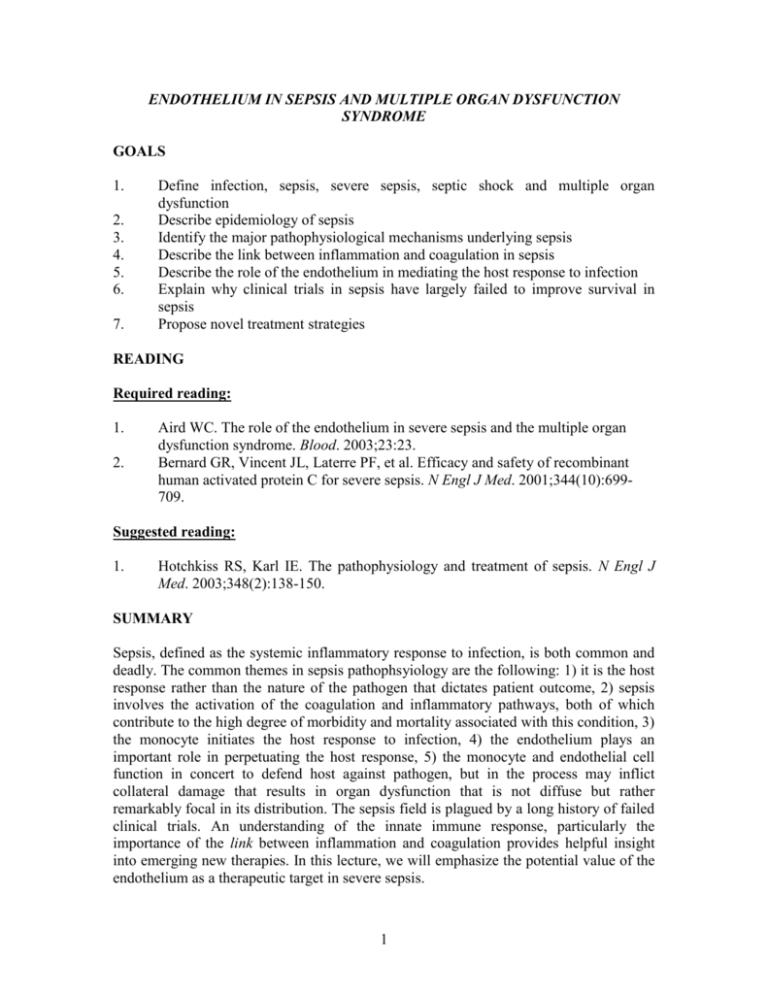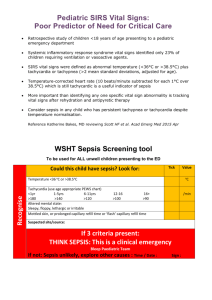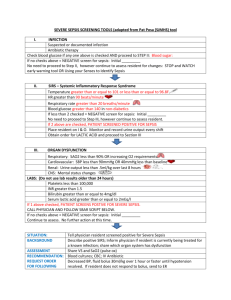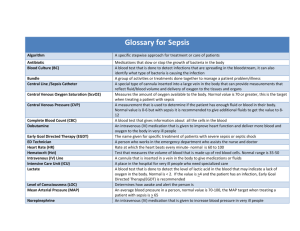4/22/04 Endothelium in Sepsis and Multiple Organ Dysfunction
advertisement

ENDOTHELIUM IN SEPSIS AND MULTIPLE ORGAN DYSFUNCTION SYNDROME GOALS 1. 2. 3. 4. 5. 6. 7. Define infection, sepsis, severe sepsis, septic shock and multiple organ dysfunction Describe epidemiology of sepsis Identify the major pathophysiological mechanisms underlying sepsis Describe the link between inflammation and coagulation in sepsis Describe the role of the endothelium in mediating the host response to infection Explain why clinical trials in sepsis have largely failed to improve survival in sepsis Propose novel treatment strategies READING Required reading: 1. 2. Aird WC. The role of the endothelium in severe sepsis and the multiple organ dysfunction syndrome. Blood. 2003;23:23. Bernard GR, Vincent JL, Laterre PF, et al. Efficacy and safety of recombinant human activated protein C for severe sepsis. N Engl J Med. 2001;344(10):699709. Suggested reading: 1. Hotchkiss RS, Karl IE. The pathophysiology and treatment of sepsis. N Engl J Med. 2003;348(2):138-150. SUMMARY Sepsis, defined as the systemic inflammatory response to infection, is both common and deadly. The common themes in sepsis pathophsyiology are the following: 1) it is the host response rather than the nature of the pathogen that dictates patient outcome, 2) sepsis involves the activation of the coagulation and inflammatory pathways, both of which contribute to the high degree of morbidity and mortality associated with this condition, 3) the monocyte initiates the host response to infection, 4) the endothelium plays an important role in perpetuating the host response, 5) the monocyte and endothelial cell function in concert to defend host against pathogen, but in the process may inflict collateral damage that results in organ dysfunction that is not diffuse but rather remarkably focal in its distribution. The sepsis field is plagued by a long history of failed clinical trials. An understanding of the innate immune response, particularly the importance of the link between inflammation and coagulation provides helpful insight into emerging new therapies. In this lecture, we will emphasize the potential value of the endothelium as a therapeutic target in severe sepsis. 1 QUESTIONS 1. Why has single mediator anti-inflammatory and anticoagulant therapy failed to improve organ dysfunction and survival in sepsis trials? 2. Why did activated protein C improve organ dysfunction and survival, whereas antithrombin III or tissue factor pathway inhibitor did not? 3. Of the five interventions that have been shown to improve survival in these patients (activated protein C, low tidal volume ventilation, insulin therapy, early intervention, low dose steroids), which are likely to modulate the endothelium and how? 4. If you were to design/test a new therapy for sepsis, what would be your priority in targets: Monocytes? Endothelial cells? Inflammation? Coagulation? 5. What is the butterfly effect of chaos theory and how might this apply to sepsis therapy? 6. Patients with trauma may develop a similar systemic inflammatory response and organ dysfunction. If the innate immune response is important in the trauma patient, what is the trigger? How would your approach to therapy differ in these patients? Specifically, would activated protein C be useful? 2






